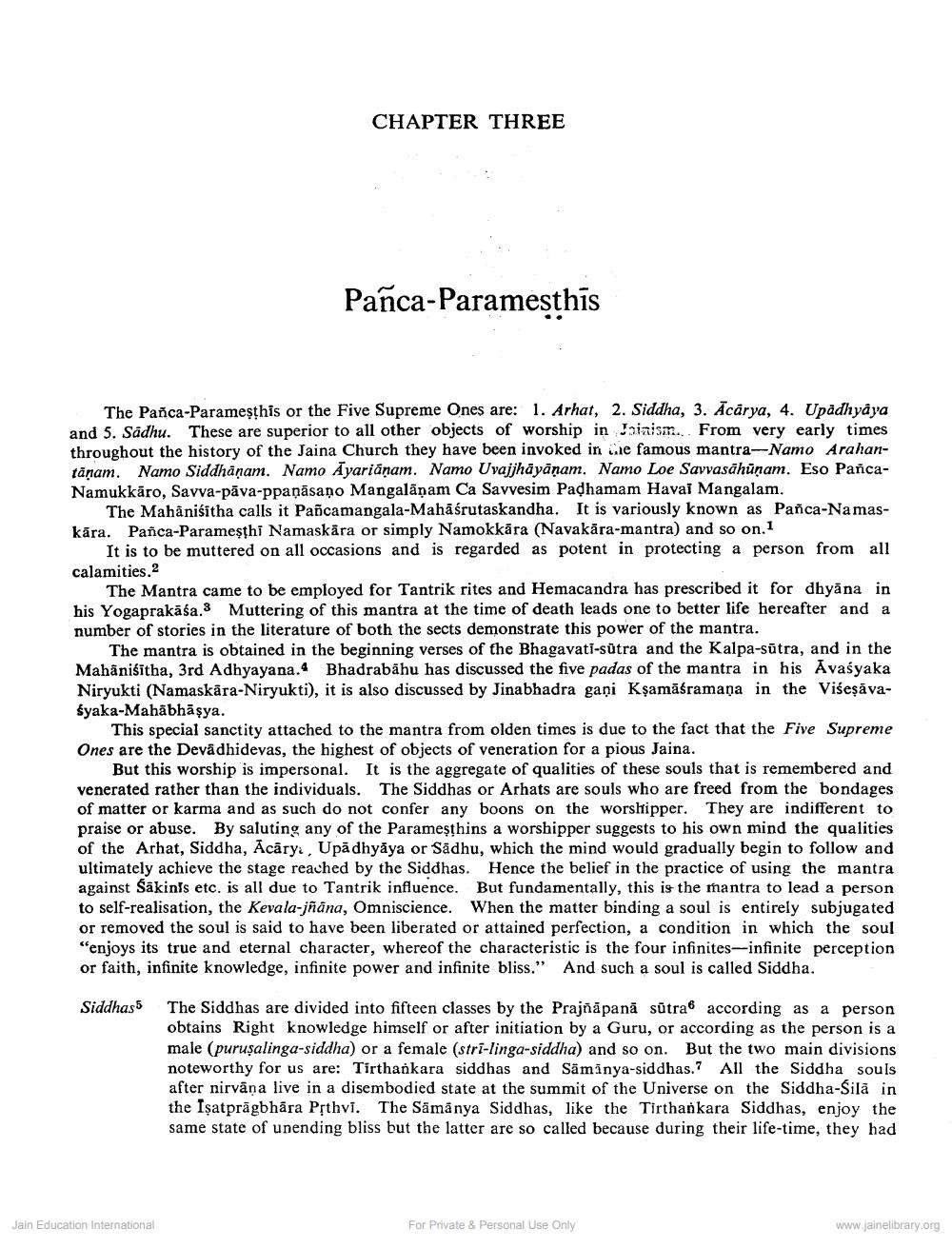________________
CHAPTER THREE
Pañca-Paramesthīs
The Pañca-Parameşthis or the Five Supreme Ones are: 1. Arhat, 2. Siddha, 3. Ācārya, 4. Upadhyaya and 5. Sådhu. These are superior to all other objects of worship in Jaiais... From very early times throughout the history of the Jaina Church they have been invoked in Che famous mantra--Namo Arahantanam. Namo Siddhanam. Namo Ayariānam. Namo Uvajjhāyānam. Namo Loe Savvasāhūnam. Eso PancaNamukkāro, Savva-pāva-ppanäsano Mangalānam Ca Savvesim Padhamam Havai Mangalam.
The Mahāniśitha calls it Pancamangala-Mahāśrutaskandha. It is variously known as Pañca-Namaskāra. Panca-Parameşthi Namaskara or simply Namokkāra (Navakāra-mantra) and so on.1
It is to be muttered on all occasions and is regarded as potent in protecting a person from all calamities.2
The Mantra came to be employed for Tantrik rites and Hemacandra has prescribed it for dhyāna in his Yogaprakāśa.3 Muttering of this mantra at the time of death leads one to better life hereafter and a number of stories in the literature of both the sects demonstrate this power of the mantra.
The mantra is obtained in the beginning verses of the Bhagavati-sütra and the Kalpa-sūtra, and in the Mahanišitha, 3rd Adhyayana. Bhadrabahu has discussed the five padas of the mantra in his Avaśyaka Niryukti (Namaskāra-Niryukti), it is also discussed by Jinabhadra gani kşamāśramana in the Višeşāvaśyaka-Mahābhāşya.
This special sanctity attached to the mantra from olden times is due to the fact that the Five Supreme Ones are the Devädhidevas, the highest of objects of veneration for a pious Jaina.
But this worship is impersonal. It is the aggregate of qualities of these souls that is remembered and venerated rather than the individuals. The Siddhas or Arhats are souls who are freed from the bondages of matter or karma and as such do not confer any boons on the worshipper. They are indifferent to praise or abuse. By saluting any of the Parameşthins a worshipper suggests to his own mind the qualities of the Arhat, Siddha, Acāry., Upadhyāya or Sadhu, which the mind would gradually begin to follow and ultimately achieve the stage reached by the Siddhas. Hence the belief in the practice of using the mantra against Säkin's etc. is all due to Tantrik influence. But fundamentally, this is the mantra to lead a person to self-realisation, the Kevala-jnana, Omniscience. When the matter binding a soul is entirely subjugated or removed the soul is said to have been liberated or attained perfection, a condition in which the soul "enjoys its true and eternal character, whereof the characteristic is the four infinites-infinite perception or faith, infinite knowledge, infinite power and infinite bliss." And such a soul is called Siddha.
Siddhas 5
The Siddhas are divided into fifteen classes by the Prajñāpanā sutra according as a person obtains Right knowledge himself or after initiation by a Guru, or according as the person is a male (puruşalinga-siddha) or a female (stri-linga-siddha) and so on. But the two main divisions noteworthy for us are: Tirthankara siddhas and Säminya-siddhas. All the Siddha souls after nirvana live in a disembodied state at the summit of the Universe on the Siddha-Sila in the Isatprāgbhāra Prthvi. The Sämänya Siddhas, like the Tirthankara Siddhas, enjoy the same state of unending bliss but the latter are so called because during their life-time, they had
Jain Education International
For Private & Personal Use Only
www.jainelibrary.org




